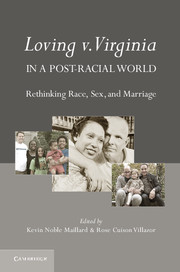Book contents
- Frontmatter
- Contents
- About the Contributors
- Acknowledgments
- Foreword
- Introduction Loving v. Virginia in a Post-Racial World
- Part One Explaining Loving v. Virginia
- Part Two Historical Antecedents to Loving
- Part Three Loving and Interracial Relationships: Contemporary Challenges
- 6 The Multiracial Epiphany, or How to Erase an Interracial Past
- 7 Love at the Margins
- 8 The Crime of Loving
- 9 What’s Loving Got to Do with It?
- 10 Fear of a “Brown” Planet
- Part Four Considering the Limits of Loving
- Part Five Loving Outside the U.S. Borders
- Part Six Loving and Beyond: Marriage, Intimacy, and Diverse Relationships
- Permission Granted
- Index
- References
9 - What’s Loving Got to Do with It?
Law Shaping Experience and Experience Shaping Law
Published online by Cambridge University Press: 05 July 2012
- Frontmatter
- Contents
- About the Contributors
- Acknowledgments
- Foreword
- Introduction Loving v. Virginia in a Post-Racial World
- Part One Explaining Loving v. Virginia
- Part Two Historical Antecedents to Loving
- Part Three Loving and Interracial Relationships: Contemporary Challenges
- 6 The Multiracial Epiphany, or How to Erase an Interracial Past
- 7 Love at the Margins
- 8 The Crime of Loving
- 9 What’s Loving Got to Do with It?
- 10 Fear of a “Brown” Planet
- Part Four Considering the Limits of Loving
- Part Five Loving Outside the U.S. Borders
- Part Six Loving and Beyond: Marriage, Intimacy, and Diverse Relationships
- Permission Granted
- Index
- References
Summary
In 1955, I was born to a white mother and an African-American father in Springfield, Illinois. Except for the three years that my family lived in Germany, we lived in a transitional neighborhood near where Abraham Lincoln lived when he was elected president. Railroad tracks at 10th Street separated the neighborhood from the center of town determined by the Old State Capitol Building where Lincoln delivered the “House Divided” speech. During my youth, the neighborhood was an integrated neighborhood of middle-class white and African-American residents, but eventually became an African-American neighborhood comprised of families of more fragile economic status. When I was about ten, an African-American playmate, whose family was relatively new to Springfield, asked whether it was illegal for my parents to be married. I was surprised to discover that I would be expected to defend my parent’s marriage even as I was developing my own sense of racial identity and coming to terms with the racial identities assigned me by others.
That first childhood encounter with other people’s views of the racial identity of my family illustrates both the liberating and limiting impacts of law in shaping the lived experience of families formed through interracial marriages. Today, as an adult and a lawyer, I have the tools to reflect on the transformative impact of the Supreme Court’s decision in Loving v. Virginia – and other civil rights cases of the 1950s and 1960s – in enabling me to make certain life choices, such as where to go to school, where to live, where to eat and shop, and who to marry, on the same basis that white Americans had long taken for granted. While Loving gave the imprimatur of the legal establishment to the concept of interracial marriage, my conversation with a childhood neighbor and other personal experiences illustrate that legal recognition is not sufficient to alter settled societal expectations and practices. Race still matters in the choices most individuals make regarding marriage and in their reactions to the marriages of others. Loving did not settle these matters for all time and for all Americans. A parallel history is evolving as the legal system and society react to demands of same-sex couples for full equality with respect to legal recognition of their relationships and all the rights and responsibilities such recognition entails.
- Type
- Chapter
- Information
- Loving v. Virginia in a Post-Racial WorldRethinking Race, Sex, and Marriage, pp. 128 - 140Publisher: Cambridge University PressPrint publication year: 2012



